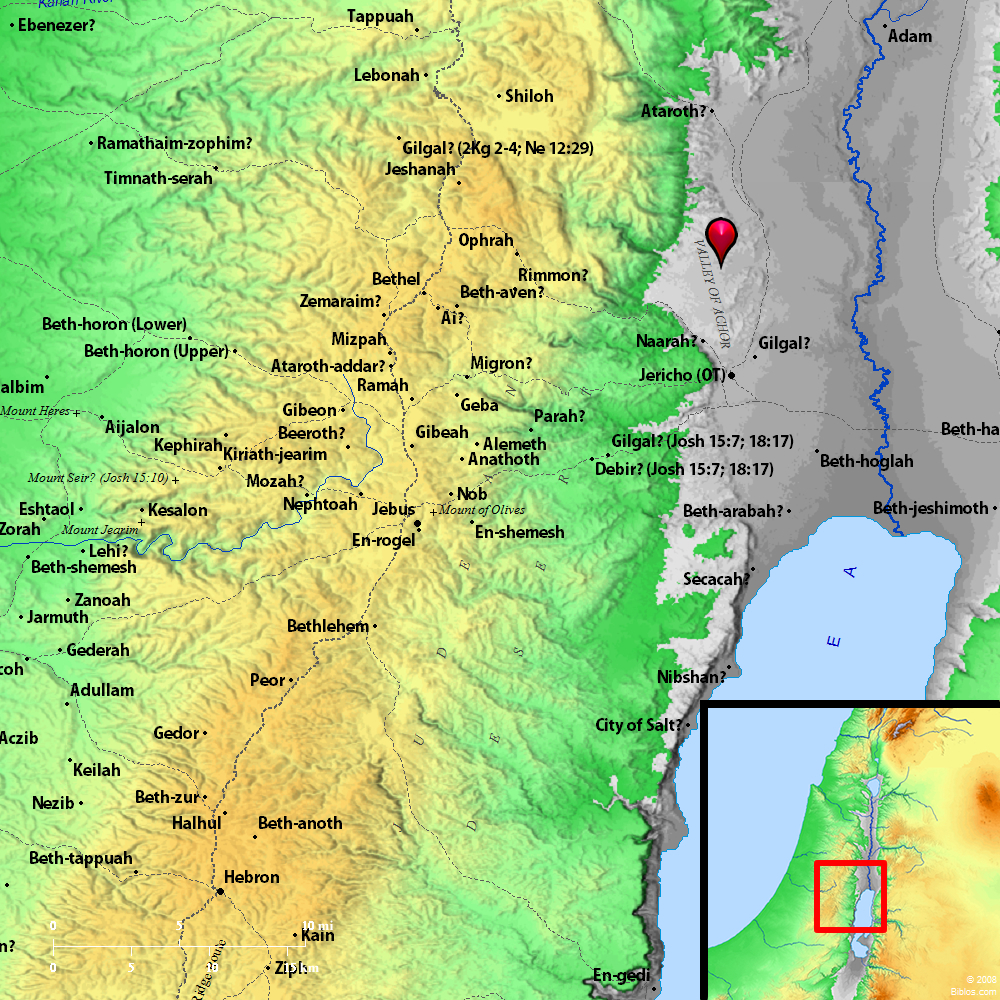Atlas  Valley of Achor and surrounding region Maps Created using Biblemapper 3.0 Additional data from OpenBible.info You are free to use up to 50 Biblos coprighted maps (small or large) for your website or presentation. Please credit Biblos.com. Occurrences Joshua 7:24 Joshua, and all Israel with him, took Achan the son of Zerah, the silver, the robe, the wedge of gold, his sons, his daughters, his cattle, his donkeys, his sheep, his tent, and all that he had; and they brought them up to the valley of Achor.Joshua 7:26 They raised over him a great heap of stones that remains to this day. Yahweh turned from the fierceness of his anger. Therefore the name of that place was called "The valley of Achor" to this day. Joshua 15:7 The border went up to Debir from the valley of Achor, and so northward, looking toward Gilgal, that is over against the ascent of Adummim, which is on the south side of the river. The border passed along to the waters of En Shemesh, and ended at En Rogel. Isaiah 65:10 Sharon shall be a fold of flocks, and the valley of Achor a place for herds to lie down in, for my people who have sought me. Hosea 2:15 I will give her vineyards from there, and the valley of Achor for a door of hope; and she will respond there, as in the days of her youth, and as in the day when she came up out of the land of Egypt. Encyclopedia ACHORa'-kor (`akhor, "trouble," the idea of the word being that of trouble which is serious and extreme. See ACHAN): The place where Achan was executed in the time of Joshua (Joshua 7:24, 26). In all the five places where it is mentioned it is described as the `emek, the arable valley of Achor. There is no ground in the record for the current idea that it must have been a locality with horrid and dismal physical features. It was on a higher level than the camp of Israel in the Jordan valley, and on a lower level than Debir-a different Debir from that of Joshua 15:15. In a general way, as indicated by the points mentioned in the border of Judah, it was north of Betharabah, and south of Debir (Joshua 7:24; Joshua 15:7). Many identify it with the Wady Kelt which descends through a deep ravine from the Judean hills and runs between steep banks south of the modern Jericho to Jordan, the stream after rams becoming a foaming torrent. Possibly the name may have been applied to a region of considerable extent. In Isaiah 65:10 it is a region on the east side of the mountain ridge which is in some sense balanced with Sharon on the west side. By implication the thing depicted seems to be these rich agricultural localities so far recovered from desolation as to be good grounds for cattle and sheep. Hosea recognizes the comforting aspect of the dreadful affair in the valley of Achor; it was a doorway of hope to pardoned Israel (Hosea 2:15 (17)), and he hopes for like acceptance for the Israel of his own day. |



